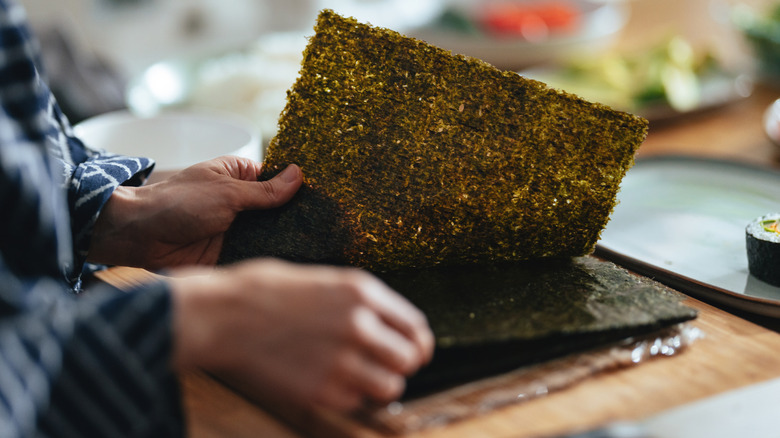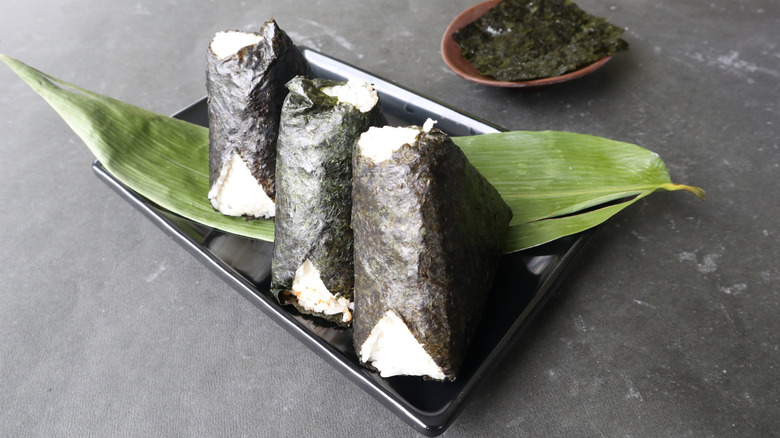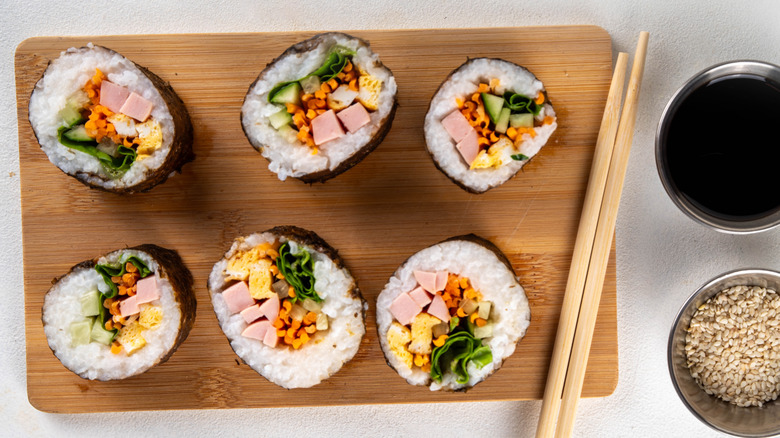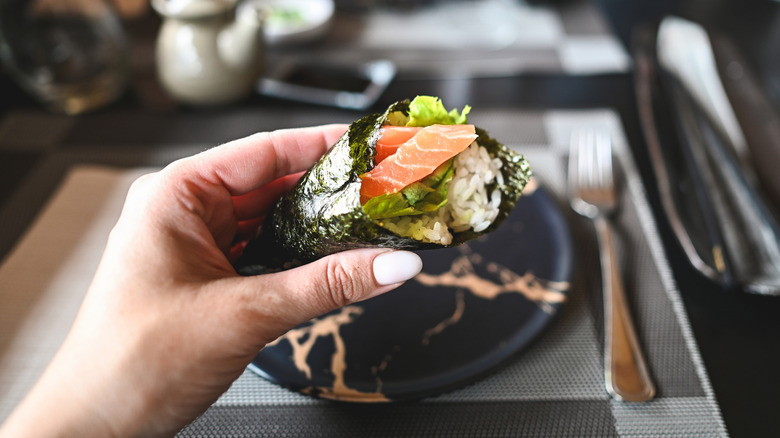5 Easy Meal Ideas That Prove Full-Size Seaweed Sheets Are Better Than The Mini Version
Numerous types of seaweed appear in Japanese, Korean, and Chinese cooking. However, in the U.S., nori has achieved the most success. You've likely encountered it already rolled into sushi, or packaged into a mini snackable form. Purchase the full-size seaweed sheets, though, and you'll have a terrific canvas for easy meals.
With seaweed's prevalence in East Asian cuisine, it's no surprise the ingredient often accompanies rice. Indeed, there is a delectable crossover of flavor and texture between the two components; the salty, oceanic flavor of the seaweed delectably seasons a batch of the grain. As a result, several of these dishes — like temaki, kimbap, and onigiri — feature this pairing in a casual construction.
However, don't sleep on the power of seaweed sheets in other realms, too. Nori's pliable nature can replicate the qualities of a lettuce wrap, or even a tortilla. There's an incredible malleability to these pressed and dried sea plants, meaning they can serve as a canvas for delightful, easy meals. You can effortlessly roll up leftovers in the fridge, while crafting new creative combinations in the process.
Make onigiri for meals on the go
A staple of Japanese convenience stores, onigiri are the ultimate seaweed sheet snack. Wrapped in a large leaf of nori, the seaweed encases a prism shape of rice, with filling inside. The shape takes on fun forms like triangular prisms or even balls, but the seaweed's function is the same: To enclose the contents for portability. Akin to a sandwich, this food is intertwined with portability and on-the-go eating in Japanese cuisine.
The simplest onigiri can consist of only rice and seaweed. Traditionally, onigiri are seasoned with salt, rather than the vinegar mirin mixture used for sushi rice. So prepare a high quality short grain rice to the proper texture, and it'll be enough to offer a delicious contrast when wrapped in nori. Nevertheless, some fillings are a welcome addition, packing in more flavor, texture, and added satiation, too.
Among the most popular combos include the dependable combination of canned tuna and mayo, as well as salted salmon, and mentaiko — salted cod roe. However, you're also welcome to stray from the classics and craft onigiri with more creative ingredients for all diets. So whether it's a batch of chicken, some delicious pickled vegetables, or even scrambled eggs, onigiri are a malleable and mouth-watering way to use large seaweed sheets.
Turn to kimbap for a Korean-inspired meal
Often confused with sushi, kimbap packs in a different array of fillings into a seaweed-rice roll. Hailing from Korea, much like onigiri, the dish is also associated with convenient cooking for on-the-go nourishment. It's a malleable template, as you can place quite a bit of filling into these large rolls. There's a layer of rice to encase whatever's inside, but as opposed to sushi, ingredients are generally more casually mixed and matched.
Of course, the most foundational component to the meal is the seaweed. Kimbap reaches for "gim," which is the Korean name for nori. You'll start dish assembly by laying out the seaweed sheet flat on a bamboo mat, ready for a range of fillings. Traditional options include pickled radish — especially daikon — burdock root, gently seared carrots, cucumbers, blanched spinach, as well as protein choices ranging from imitation crab meat to seared steak, ham, omelets, and more.
Kimbap are open to interpretation, so combine veggies and meat options that suit your tastes. Since there's no raw seafood involved, assembly comes with greater ease. Once rolled, the exterior is seasoned with sesame oil, lending the large seaweed sheet a beautiful sheen.
Stage a do-it-yourself temaki night
Many seaweed sheet recipes involve rolling and folding each portion during prep, which proves laborious for larger crowds. So instead, integrate a dash of spontaneous fun into the mix by letting guests assemble the seaweed themselves. A Japanese concept called "temaki," this involves crafting rolls from a spread of ingredients amidst dining. A bit like a taco night, you'll lay out a tantalizing combination of proteins and toppings, and then let each guest decide based on their preferences.
Traditionally, temaki involves do-it-yourself sushi rolls, wrapped up into a cone shape. Seafood options are numerous: Think long filleted strips of salmon, tuna, mackerel, crab sticks, and further seafood options like sea urchin and roe. However, you can also throw everything from grilled chicken, to shrimp, and sausages into a temaki. Plus — with a bit of slicing prep work — vegetables like cucumber, avocado, radishes, greens, and more are present. Temaki can involve a higher ratio of vegetarian ingredients than a sushi night. And for a dipping, don't forget a side of high quality soy sauce; it'll meld all the flavors together well.
You'll need to cut the large nori sheets in half, yielding a size that can be held in the palm of your hand. Whenever guests select their filling, they'll fold and wrap diagonally or across. As opposed to other seaweed creations, this recipe does not require a bamboo mat, letting you enjoy the sheets with greater ease.
Craft rice-less seaweed wraps
Undoubtedly, seaweed and rice do complement each other. However, the grain isn't a necessity — you can craft wraps employing exclusively the large sheet. The malleable consistency, as well as gentle sea flavors, are the perfect pairing for a batch of crispy vegetables and enabling completely vegan creations. Natural integrations are sushi roll favorites, like carrot sticks, long bites of cucumber, as well as creamy slices of avocado. Although you can further enhance satiation by folding in calorie-dense meatless foods like hummus, nut butters, or tofu to turn the wrap into a full meal.
The large seaweed sheets are a terrific canvas for seafood and meat options, too. Throw in some tuna salad for an especially easy-to-assemble roll, although anything from grilled chicken to even leftover beef roast also melds well with the seaweed. Rather than a meticulously assembled sushi roll, such nori wraps can function like a fun twist for a fridge cleanout.
Just don't skimp on seasoning, as some extra flavors can go a long way. Adding some bright and spicy microgreens, tart mango, or a shake of chili seasoning can complete the mix. You can also always add more pungent ingredients like pickled kimchi or an extra dash of citrus juice if it turns out too bland. Alternatively, improve flavors with the rolling vessel itself; salted and lightly oiled seaweed will lend an enhanced mouthfeel. Play around with all the options — rice-less rolls present especially open-ended possibilities.
Fold large seaweed sheets into a sandwich
Most often, seaweed sheets are rolled around into a cylindrical shape. However, you can also use them as a delicious canvas by folding over into a sandwich-like creation. Known in Japan as "onigirazu," it's a spin-off of onigiri, but with a heftier filling. The internal rice and ingredients aren't as tightly packed, so you can integrate everything from leftover chicken, to tuna, tofu, or fried pork. Plus, since the nori is folded over flat-side down, there's no need to cut into strips.
Like a bread-based sandwich, consider fun combinations of condiments and sauces for flavor. Whether it's salmon and teriyaki, or chicken cutlets and crunchy homemade pickles, the nori sandwich presents a malleable canvas for flavors. And the large shape is excellent with a dipping sauce alongside; craft a thick sauce like a spicy mayo for the best dunking ability.
Furthermore, for the easiest take on the dish, place a different ingredient in every quadrant of the seaweed sheet, and then fold over into a layered creation. Sure, the result won't be as tidy as a roll, but the crunchy, yet casual nature of the sandwich highlights seaweed sheets in unique fashion.





